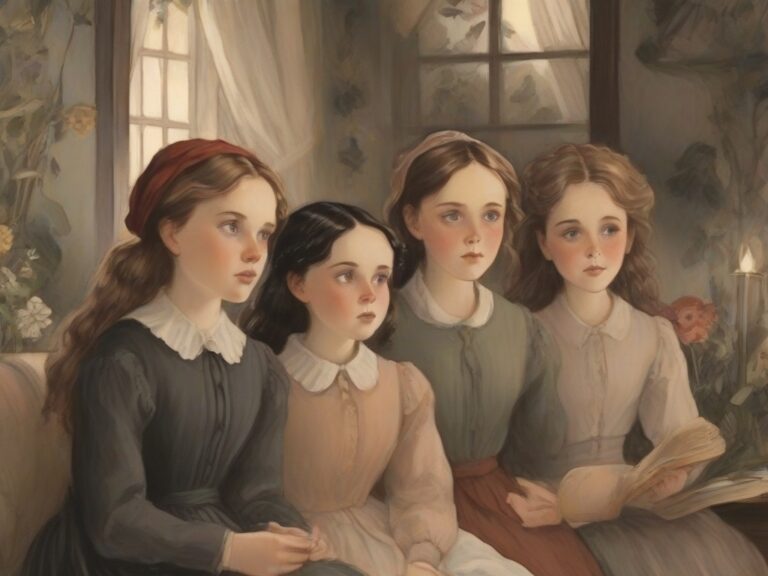Are you curious to unravel the timeless tale that has captured hearts for generations? Delve into the enchanting world of Louisa May Alcott’s literary masterpiece, “Little Women.” This beloved coming-of-age novel, set against the backdrop of the American Civil War, introduces readers to four spirited sisters—Meg, Jo, Beth, and Amy March—as they navigate the trials and triumphs of adolescence. With historic significance, Alcott’s poignant portrayal of family, sisterhood, and societal expectations continues to resonate with readers of all ages.
Join us as we embark on an extraordinary journey, exploring the cherished characters and thought-provoking themes bestowed within the pages of “Little Women,” maximizing your user retention until the final word.
Little Women: Full Book Summary
Once upon a time, in a small town called Concord, there lived four sisters named Meg, Jo, Beth, and Amy. They were quite different from each other, but they loved each other dearly. Their father was fighting in the Civil War, so they lived with their mother, known as Marmee. The story of these girls and their journey through life is told in the remarkable book called “Little Women,” written by Louisa May Alcott.
In “Little Women,” we get to know each sister and witness their joys, sorrows, and everyday adventures. The eldest sister, Meg, is the beauty of the family. She dreams of a life filled with fancy dresses and luxurious parties. Meg often feels the need to fit in with society’s expectations, but in the end, she learns that true happiness lies in simpler things.
Jo, the second eldest sister, is a lively and tomboyish girl who is passionate about writing. She aspires to become a famous author and often creates imaginative plays for her sisters to perform. Jo is full of mischief and often gets into trouble, but her determination and courage shine through when she faces adversity.
Beth, the third sister, is the quiet and gentle one. She has a deep love for music and playing the piano. Beth’s kind heart and selflessness touch the lives of everyone around her, but she also faces health struggles that challenge her strength and resilience.
Lastly, there is the youngest sister, Amy, who is creative and artistic. Amy dreams of becoming a great artist and often expresses herself through her art. She can be a bit spoiled and selfish at times, but as the story progresses, Amy learns the importance of empathy and kindness.
Throughout the book, we also meet other characters who play vital roles in the sisters’ lives. Laurie, a charming and mischievous boy who becomes the girls’ neighbor, becomes their dear friend and confidant. Laurie’s grandfather, known fondly as Mr. Laurence, takes an interest in the sisters and offers them guidance and support.
As the story unfolds, the sisters face various challenges and learn important life lessons. Meg experiences the ups and downs of marriage, learning that love and commitment are more important than material possessions. Jo struggles to find her place in the world of literature, facing rejection and disappointment, but ultimately realizing that true success comes from staying true to oneself.
Beth’s fragile health worsens, and her sisters rally around her, providing love and support until her untimely passing. It is through Beth’s death that the girls learn the value of cherishing every moment and the power of family bonds.
Amy, on the other hand, travels to Europe with their Aunt March and learns about different cultures and the importance of education. She grows into a poised and refined young woman, realizing that true beauty comes from within.
As the girls navigate their individual journeys, they always come back to one another, drawing strength and inspiration from their sisterhood. They cherish their traditions, such as performing plays and celebrating Christmas together, which remind them of the importance of family and togetherness.
In the end, the sisters come to understand that life is filled with both joy and sorrow. They navigate adulthood, experiencing love, heartbreak, and the beauty of friendship. They learn the significance of perseverance, kindness, and the importance of staying true to themselves.
“Little Women” is a timeless classic that continues to captivate readers of all ages. It beautifully depicts the bonds of sisterhood, the power of family, and the journey of self-discovery. Through the lives of Meg, Jo, Beth, and Amy, we learn valuable lessons about love, friendship, and the pursuit of happiness. Louisa May Alcott’s words are like a warm embrace, reminding us that no matter how different we are, the bonds of love and sisterhood can overcome any obstacle, making “Little Women” a book cherished by generations.
Little Women: Key Themes
Little Women is a coming-of-age novel written by Louisa May Alcott, published in 1868. Set in the 19th century during the Civil War, the story revolves around the lives of the four March sisters – Meg, Jo, Beth, and Amy – as they navigate the challenges and joys of growing up and finding their own paths in life.
1. Sisterhood and Family Bonds: One of the key themes in Little Women is the strong bond between the four March sisters. Though they have different personalities and interests, their love and support for each other remains steadfast throughout the ups and downs of life. Alcott emphasizes the significance of sisterhood, portraying it as a source of comfort, strength, and resilience. The sisters share a deep understanding and connection, always putting each other’s well-being above their own. The emphasis on family values and the importance of sibling relationships make this theme central to the book.
2. Gender Roles and Femininity: Little Women explores the limitations and expectations society placed on women during the 19th century. The March sisters challenge traditional gender roles by pursuing their individual passions and dreams, often going against societal norms. Jo March, in particular, stands out as a character defying the conventional expectations of marriage and motherhood, instead aspiring to be a writer. Alcott addresses these themes by showcasing the sisters’ struggles, sacrifices, and triumphs in their quest for independence and self-fulfillment.
3. Virtues and Morality: Another significant theme in Little Women is the importance of cultivating positive values and ethics. The March sisters are portrayed as virtuous and principled individuals who prioritize kindness, generosity, humility, and compassion. They learn the value of selflessness through their interactions with friends, family, and their neighboring community. The book explores the rewards and challenges that come with living a life guided by moral principles, emphasizing the importance of integrity and personal growth.
Overall, Little Women is a story that focuses on the strength of family ties, the resilience of women in a patriarchal society, and the significance of upholding positive morals and values. It continues to resonate with readers of all ages, reminding us of the power of love, sisterhood, and the pursuit of individual passions amidst societal expectations.
Little Women: Characters
– Jo March: The fiercely independent and passionate protagonist of the story. Jo is a tomboy with a wild imagination and a knack for storytelling. With her unruly hair, freckles, and mischievous grin, she is a force to be reckoned with. Jo aspires to be a writer and dreams of setting the world on fire with her words. Her unconventional nature often gets her into trouble, but her determination and loyalty to her family are unwavering. Funny data: Jo can be found with ink-stained fingers and a pile of books wherever she goes.
– Meg March: The oldest of the four March sisters, Meg is the embodiment of grace and femininity. With her elegant curls, hazel eyes, and a smile that lights up the room, she is often seen as the epitome of beauty. Meg is kind-hearted, responsible, and holds strong traditional values. Despite her dreams of a life filled with luxury, Meg finds joy in her role as a wife and mother. Funny data: Meg secretly enjoys indulging in a guilty pleasure of snacking on chocolates in the pantry.
– Beth March: The shy and delicate third sister in the March family. Beth is like a gentle breeze, bringing peace and calmness wherever she goes. Her golden locks and big blue eyes make her seem almost angelic. Beth possesses a musical talent, playing the piano with a tenderness that touches the soul. She is selfless and compassionate, always putting others’ needs before her own. Funny data: Beth has a soft spot for animals and can often be found having deep conversations with her pet canary.
– Amy March: The youngest of the March sisters, Amy is a petite, blond beauty with sparkling green eyes. Although initially seen as spoiled and vain, Amy grows into a strong-willed and ambitious young woman. Her artistic talents shine through her delicate brushstrokes and creative drawings. Amy dreams of a life filled with luxury and often finds herself daydreaming about exquisite European destinations. Funny data: Amy has a knack for creating elaborate schemes to get her way, often causing mischief for her sisters.
– Marmee March: The steadfast and loving matriarch of the March family. Marmee, with her warm smile and kind eyes, is the pillar of strength for her daughters. She possesses a calming presence and provides guidance in times of trouble. Marmee is an advocate for equality and teaches her daughters the importance of kindness and empathy. Funny data: Marmee has a hidden talent for baking, and her pies are legendary within their community.
Little Women: Symbols
1. The umbrella – The umbrella is a recurring symbol in the book, representing protection and shelter. It is used to illustrate the bond between the March sisters and their mother, Marmee. In the absence of their father, the umbrella symbolizes Marmee’s role as the sole provider and protector of her daughters. It also reflects the warmth and security the girls find within their home, as they lean on one another for support.
2. The attic – The attic is a symbol of the transformation and growth of the March sisters throughout the novel. Initially, the attic is a cramped and simple space, where the sisters gather to tell stories and perform plays. However, as the girls face challenges and cultivate their individual talents, the attic becomes a place of creativity and personal development. It symbolizes the metaphorical journey the girls embark on as they strive to achieve their dreams and find their place in the world.
3. The pickled limes – The pickled limes serve as symbols of social conformity and exclusion. In the novel, the March sisters attend a strict boarding school where it becomes a trend to smuggle and eat pickled limes, despite them being forbidden. The pickled limes represent the desire to fit in and participate in popular culture, even if it means breaking the rules. However, Jo March refuses to conform to the fad, showing her individuality and her refusal to be swayed by peer pressure. This symbol highlights the importance of staying true to oneself and resisting societal expectations.
Little Women: Culture Impact
Little Women, written by Louisa May Alcott, has had a profound and enduring cultural impact since its publication in 1868. This heartwarming novel, set during the Civil War, follows the lives of the four March sisters – Meg, Jo, Beth, and Amy – as they navigate the challenges of growing up and finding their place in the world. From historical influence to humorous anecdotes and remarkable achievements, Little Women has left an indelible mark on our society.
Historically, Little Women offers a glimpse into the lives of American women during the 19th century. It reflects the societal expectations placed on women, highlighting themes of domesticity, sisterhood, and female empowerment. The book resonated deeply with readers of the time, presenting alternative and more progressive notions of femininity. It inspired countless young girls to dream beyond their prescribed roles and encouraged them to find their own voice and purpose in life.
On the lighter side, Little Women has become a treasure trove of amusing stories and anecdotes. One such story involves Alcott receiving letters from fans demanding that she either marry Jo March off to Laurie or kill her character altogether. The fans were divided into two camps: Team Jo-Laurie and Team Jo-Bhaer (her eventual husband). This passionate debate among readers showcases the emotional connection people formed with the characters, thereby highlighting the book’s ability to captivate and engage its audience.
Moreover, Little Women achieved remarkable feats, both literary and cultural. It became an instant success upon its release, captivating readers of all ages and leaving them in awe of the March sisters’ bond and resilience. Its popularity was such that it led to a spin-off series of books, sequels, movies, plays, and even modern adaptations. Little Women has been translated into multiple languages, ensuring its impact extends far beyond its American origins. It has also inspired countless literary and artistic works, even serving as the source of inspiration for other celebrated authors.
Perhaps the most noteworthy achievement of Little Women lies in its effect on generations of readers. The novel has been cherished by millions for over a century, enchanting young girls and women with relatable characters and heartfelt narratives. It has touched the lives of readers across cultures and epochs, resonating with themes of family, love, and perseverance. Little Women has not only shaped the perception of literature but has also influenced social and cultural movements by promoting equality, female empowerment, and emotional resilience.
In conclusion, Little Women’s cultural impact cannot be overstated. From its historical significance in challenging societal expectations, to the humorous episodes it has sparked, and the remarkable achievements it has garnered, Alcott’s novel has become an enduring classic. Its ability to captivate hearts and minds has made it a beloved book cherished by readers of all ages and continues to inspire and shape our collective understanding of feminism, family values, and the strength of female friendship.
FAQs
1. Is “Little Women” a classic novel?
Yes, “Little Women” is considered a classic novel. It was written by Louisa May Alcott and published in 1868, and it has since become one of the most beloved and enduring works in literature.
2. What is “Little Women” about?
“Little Women” follows the lives of the four March sisters – Meg, Jo, Beth, and Amy – as they navigate the challenges and joys of adolescence and young adulthood. The novel explores themes of family, love, sisterhood, and personal growth.
3. Is “Little Women” a feminist book?
“Little Women” is often seen as a feminist book due to its portrayal of strong-willed, independent female characters and its exploration of the limited opportunities available to women in the 19th century. However, it is important to note that the term “feminism” didn’t exist at the time the book was written, so the author’s intentions might be interpreted differently from a modern perspective.
4. Are the characters in “Little Women” based on real people?
While “Little Women” draws inspiration from Louisa May Alcott’s own family, it is considered a work of fiction. The March sisters are fictional characters, although they may share some similarities with Alcott and her own sisters.
5. Is “Little Women” suitable for all ages?
“Little Women” is generally considered suitable for readers of various ages. However, it is important to note that the novel deals with themes that might be more relatable and appreciated by older readers, such as coming-of-age, marriage, and societal expectations. Younger readers may still enjoy the book, but might not fully grasp certain nuances.
6. What is the main message of Little Women?
The main message of Little Women is that women can be strong, independent, and successful in their own ways, and that they should pursue their dreams and happiness. The novel shows how the four March sisters, Meg, Jo, Beth, and Amy, grow up and face the challenges and opportunities of the 19th-century America. The novel also celebrates the values of family, friendship, love, and generosity.
7. What is the significance of the novel’s opening line?
The novel’s opening line introduces the main characters, the four March sisters, and their situation, which is that they are poor and their father is away at war. It also sets the tone for the rest of the story, which is a mixture of realism and sentimentality, humor and tragedy, and individuality and conformity. The opening line also foreshadows the themes of the novel, such as poverty, war, gender roles, and personal growth.
8. Why does Jo reject Laurie’s proposal?
Jo rejects Laurie’s proposal because she does not love him romantically, and she thinks that they are too similar and impulsive to make a good match. She also values their friendship more than a possible marriage, and she does not want to give up her independence and ambition. She thinks that Laurie deserves someone who can love him as he loves her, and she encourages him to find his true happiness.
9. What does Mr. Laurence give to Beth?
Mr. Laurence gives Beth his granddaughter’s piano, which is a very generous and kind gesture. He does this because he sees that Beth loves music and has a gentle and sweet nature. He also feels lonely and wants to befriend the March family, especially Beth, who reminds him of his granddaughter. The piano becomes a symbol of Beth’s talent, joy, and friendship with Mr. Laurence.
10. What does the title Little Women really mean?
The title Little Women refers to the four March sisters, who are young and inexperienced, but also brave and resilient. The title also reflects the social expectations and limitations that women faced in the 19th-century society, which often treated them as inferior and dependent on men. The title also suggests the contrast between the sisters’ humble beginnings and their eventual achievements and happiness.










